The Story Behind the Photograph
How I photographed the Barn Swallows Flying
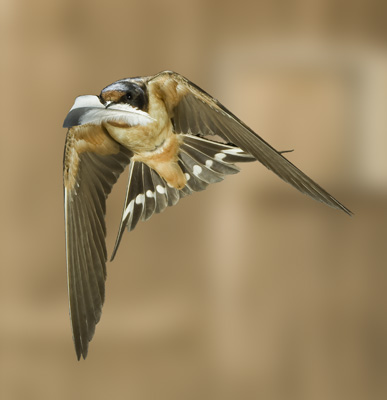
Although I'm writing this in winter it is not too late to think about exciting spring and summer photo projects. One of the most exciting and rewarding, and potentially challenging, projects you can do is capture action with high speed flash and camera remotes. If you look at the list at the bottom of this page, you'll see another example of this type of photography, with the striking rattlesnake story.
When I refer to high speed flash I do not mean expensive, specialty units. Years ago I purchased special high speed flash units, but the manufacturers of these custom units either died or got out of the business. Presently I still own, and can get repairs for, one high speed system, but most frequently I just use regular hot-shoe style flashes. In other words, I'm using my Canon 440 and 550 and 580 flashes, or old Nikon SB units, or Vivitar $100 units.
When I refer to high speed flash, I am talking about dialing the power ratio/output of the flashes so that the flash duration is very fast. On full power, a flash duration may be as slow as 1/800th or 1/1000th second, but dialed down to 1/16 power the same flash may have a duration of 1/8,000th second or faster. That's high speed.
The only disadvantage these hotshoe flashes have is that the actual output, the Guide Number, is low, so at very low power the flashes have to be very close to the subject if you're using apertures of f16 or greater. That can compromise flash placement but it can be dealt with, and has to be, really, if you're using those units.
The bigger issue is catching the peak action, with the camera firing while the subject is in the frame. You cannot do this manually. A barn swallow, for example, flies through an open window (where these shots were taken) like a bullet, and it'd be impossible to react and fire the camera in time. To do this, some type of tripping device must be used, where the subject, in this case the barn swallow, breaks an infrared or laser beam and sends a signal to the camera or flash to fire.
If you are attaching a camera to a tripping device, then you're also going to have to deal with lag time -- the amount of time it takes for the camera to actually fire after it receives a signal from the tripper. This lag time is basically a delay. Think of it this way -- if you sprinted towards a building with an automatic door opener, you might smash into the door before it had time to open. The sensor knew you were there, but the mechanics of the door prevented it from opening fast enough. With a camera, it works the same way, and a subject may break a beam and either pass out of the frame or out of focus by the time the camera fires.
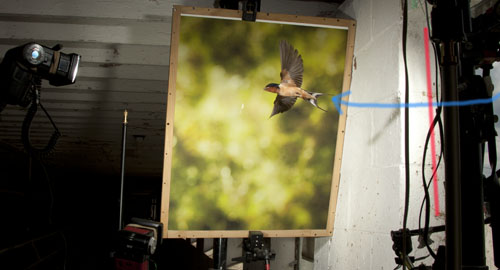
That's what the above illustration shows. The red line marks the approximate position of the infrared beam, and the point where the swallow broke the beam. Actually, it is even further to the right, even further to the right of that black pole seen in the picture, so the swallow flew about 18 inches before the camera fired.
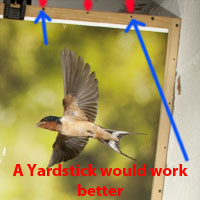
I determined where I should focus by placing a background along the side of the swallow's flight path, and then I measured the distance the bird flew after breaking the beam. On the photo (above) the 3 red marks indicate the little holes I used for reference. I should have made a grid on a board or placed a yardstick at that position so I'd have an exact measurement of the distance traveled from the sensor when the camera fired. I didn't think it all the way through, obviously. Nonetheless, it still gave me the distance and I prefocused on that point in air space. Most of the time, when the swallow broke the beam it flew at the same flight speed, and was in focus when the camera fired.
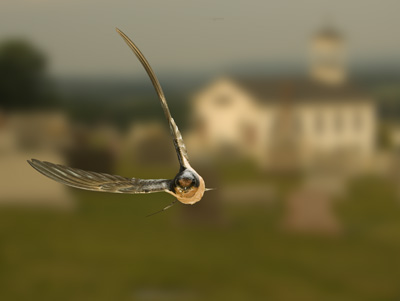
In this month's Tip of the Month I'm introducing a fantastic new remote sensor system that I've been hearing rave reviews about. I just got mine to try out, but with the winter weather I haven't been able to use it in a real application. There are several different manufacturers of tripper/sensors, including the Shutter-Beam, the PhotoTrap and the new kid on the block, the RangeIR and Stop Shot system that I refer to in the Tip. The RangeIR is a stand-alone infrared sensor that can be dialed/adjusted for different ranges, and does not require a receiver. The unit itself is both a transmitter and receiver. The RangeIR can also be hardwired into the Stop Shot for much greater flexibility, where a camera can be fired repeatedly from just one signal input, and two RangeIRs can be used with the Stop Shot for cross beam work. Their website illustrates several examples and I'll be giving a very thorough explanation of the system later on this spring.
Past Stories Behind the Photograph
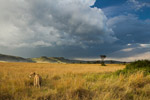
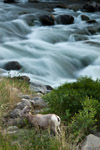
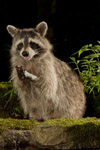
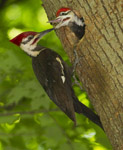
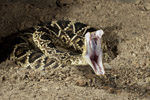

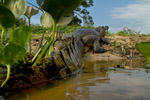
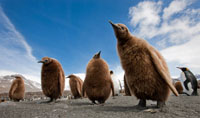
King Penguin
The Lion and the Landscape
The Bighorn Sheep
The Raccoon
The Pileated Woodpecker
The Striking Rattlesnake
The Pink Salmon
The Spectacled Caimen
Check out our latest web site,
mcdonaldwildlifephotos.com
where we'll be adding portfolios and eventually building up
a searchable data base for photo buyers. We've just started,
and the selection is limited, but it is still worth a visit!
Office Phone: (717) 543-6423
Or FAX us at: (717) 543-5342
The Story Behind the Photograph
How I photographed the Barn Swallows Flying

Although I'm writing this in winter it is not too late to think about exciting spring and summer photo projects. One of the most exciting and rewarding, and potentially challenging, projects you can do is capture action with high speed flash and camera remotes. If you look at the list at the bottom of this page, you'll see another example of this type of photography, with the striking rattlesnake story.
When I refer to high speed flash I do not mean expensive, specialty units. Years ago I purchased special high speed flash units, but the manufacturers of these custom units either died or got out of the business. Presently I still own, and can get repairs for, one high speed system, but most frequently I just use regular hot-shoe style flashes. In other words, I'm using my Canon 440 and 550 and 580 flashes, or old Nikon SB units, or Vivitar $100 units.
When I refer to high speed flash, I am talking about dialing the power ratio/output of the flashes so that the flash duration is very fast. On full power, a flash duration may be as slow as 1/800th or 1/1000th second, but dialed down to 1/16 power the same flash may have a duration of 1/8,000th second or faster. That's high speed.
The only disadvantage these hotshoe flashes have is that the actual output, the Guide Number, is low, so at very low power the flashes have to be very close to the subject if you're using apertures of f16 or greater. That can compromise flash placement but it can be dealt with, and has to be, really, if you're using those units.
The bigger issue is catching the peak action, with the camera firing while the subject is in the frame. You cannot do this manually. A barn swallow, for example, flies through an open window (where these shots were taken) like a bullet, and it'd be impossible to react and fire the camera in time. To do this, some type of tripping device must be used, where the subject, in this case the barn swallow, breaks an infrared or laser beam and sends a signal to the camera or flash to fire.
If you are attaching a camera to a tripping device, then you're also going to have to deal with lag time -- the amount of time it takes for the camera to actually fire after it receives a signal from the tripper. This lag time is basically a delay. Think of it this way -- if you sprinted towards a building with an automatic door opener, you might smash into the door before it had time to open. The sensor knew you were there, but the mechanics of the door prevented it from opening fast enough. With a camera, it works the same way, and a subject may break a beam and either pass out of the frame or out of focus by the time the camera fires.

That's what the above illustration shows. The red line marks the approximate position of the infrared beam, and the point where the swallow broke the beam. Actually, it is even further to the right, even further to the right of that black pole seen in the picture, so the swallow flew about 18 inches before the camera fired.

I determined where I should focus by placing a background along the side of the swallow's flight path, and then I measured the distance the bird flew after breaking the beam. On the photo (above) the 3 red marks indicate the little holes I used for reference. I should have made a grid on a board or placed a yardstick at that position so I'd have an exact measurement of the distance traveled from the sensor when the camera fired. I didn't think it all the way through, obviously. Nonetheless, it still gave me the distance and I prefocused on that point in air space. Most of the time, when the swallow broke the beam it flew at the same flight speed, and was in focus when the camera fired.

In this month's Tip of the Month I'm introducing a fantastic new remote sensor system that I've been hearing rave reviews about. I just got mine to try out, but with the winter weather I haven't been able to use it in a real application. There are several different manufacturers of tripper/sensors, including the Shutter-Beam, the PhotoTrap and the new kid on the block, the RangeIR and Stop Shot system that I refer to in the Tip. The RangeIR is a stand-alone infrared sensor that can be dialed/adjusted for different ranges, and does not require a receiver. The unit itself is both a transmitter and receiver. The RangeIR can also be hardwired into the Stop Shot for much greater flexibility, where a camera can be fired repeatedly from just one signal input, and two RangeIRs can be used with the Stop Shot for cross beam work. Their website illustrates several examples and I'll be giving a very thorough explanation of the system later on this spring.
Past Stories Behind the Photograph








King Penguin
The Lion and the Landscape
The Bighorn Sheep
The Raccoon
The Pileated Woodpecker
The Striking Rattlesnake
The Pink Salmon
The Spectacled Caimen
Check out our latest web site,
mcdonaldwildlifephotos.com
where we'll be adding portfolios and eventually building up
a searchable data base for photo buyers. We've just started,
and the selection is limited, but it is still worth a visit!
Office Phone: (717) 543-6423
Or FAX us at: (717) 543-5342
The Story Behind the Photograph
How I photographed the Barn Swallows Flying

Although I'm writing this in winter it is not too late to think about exciting spring and summer photo projects. One of the most exciting and rewarding, and potentially challenging, projects you can do is capture action with high speed flash and camera remotes. If you look at the list at the bottom of this page, you'll see another example of this type of photography, with the striking rattlesnake story.
When I refer to high speed flash I do not mean expensive, specialty units. Years ago I purchased special high speed flash units, but the manufacturers of these custom units either died or got out of the business. Presently I still own, and can get repairs for, one high speed system, but most frequently I just use regular hot-shoe style flashes. In other words, I'm using my Canon 440 and 550 and 580 flashes, or old Nikon SB units, or Vivitar $100 units.
When I refer to high speed flash, I am talking about dialing the power ratio/output of the flashes so that the flash duration is very fast. On full power, a flash duration may be as slow as 1/800th or 1/1000th second, but dialed down to 1/16 power the same flash may have a duration of 1/8,000th second or faster. That's high speed.
The only disadvantage these hotshoe flashes have is that the actual output, the Guide Number, is low, so at very low power the flashes have to be very close to the subject if you're using apertures of f16 or greater. That can compromise flash placement but it can be dealt with, and has to be, really, if you're using those units.
The bigger issue is catching the peak action, with the camera firing while the subject is in the frame. You cannot do this manually. A barn swallow, for example, flies through an open window (where these shots were taken) like a bullet, and it'd be impossible to react and fire the camera in time. To do this, some type of tripping device must be used, where the subject, in this case the barn swallow, breaks an infrared or laser beam and sends a signal to the camera or flash to fire.
If you are attaching a camera to a tripping device, then you're also going to have to deal with lag time -- the amount of time it takes for the camera to actually fire after it receives a signal from the tripper. This lag time is basically a delay. Think of it this way -- if you sprinted towards a building with an automatic door opener, you might smash into the door before it had time to open. The sensor knew you were there, but the mechanics of the door prevented it from opening fast enough. With a camera, it works the same way, and a subject may break a beam and either pass out of the frame or out of focus by the time the camera fires.

That's what the above illustration shows. The red line marks the approximate position of the infrared beam, and the point where the swallow broke the beam. Actually, it is even further to the right, even further to the right of that black pole seen in the picture, so the swallow flew about 18 inches before the camera fired.

I determined where I should focus by placing a background along the side of the swallow's flight path, and then I measured the distance the bird flew after breaking the beam. On the photo (above) the 3 red marks indicate the little holes I used for reference. I should have made a grid on a board or placed a yardstick at that position so I'd have an exact measurement of the distance traveled from the sensor when the camera fired. I didn't think it all the way through, obviously. Nonetheless, it still gave me the distance and I prefocused on that point in air space. Most of the time, when the swallow broke the beam it flew at the same flight speed, and was in focus when the camera fired.

In this month's Tip of the Month I'm introducing a fantastic new remote sensor system that I've been hearing rave reviews about. I just got mine to try out, but with the winter weather I haven't been able to use it in a real application. There are several different manufacturers of tripper/sensors, including the Shutter-Beam, the PhotoTrap and the new kid on the block, the RangeIR and Stop Shot system that I refer to in the Tip. The RangeIR is a stand-alone infrared sensor that can be dialed/adjusted for different ranges, and does not require a receiver. The unit itself is both a transmitter and receiver. The RangeIR can also be hardwired into the Stop Shot for much greater flexibility, where a camera can be fired repeatedly from just one signal input, and two RangeIRs can be used with the Stop Shot for cross beam work. Their website illustrates several examples and I'll be giving a very thorough explanation of the system later on this spring.
Past Stories Behind the Photograph








King Penguin
The Lion and the Landscape
The Bighorn Sheep
The Raccoon
The Pileated Woodpecker
The Striking Rattlesnake
The Pink Salmon
The Spectacled Caimen
Check out our latest web site,
mcdonaldwildlifephotos.com
where we'll be adding portfolios and eventually building up
a searchable data base for photo buyers. We've just started,
and the selection is limited, but it is still worth a visit!
Office Phone: (717) 543-6423
Or FAX us at: (717) 543-5342
The Story Behind the Photograph
How I photographed the Barn Swallows Flying

Although I'm writing this in winter it is not too late to think about exciting spring and summer photo projects. One of the most exciting and rewarding, and potentially challenging, projects you can do is capture action with high speed flash and camera remotes. If you look at the list at the bottom of this page, you'll see another example of this type of photography, with the striking rattlesnake story.
When I refer to high speed flash I do not mean expensive, specialty units. Years ago I purchased special high speed flash units, but the manufacturers of these custom units either died or got out of the business. Presently I still own, and can get repairs for, one high speed system, but most frequently I just use regular hot-shoe style flashes. In other words, I'm using my Canon 440 and 550 and 580 flashes, or old Nikon SB units, or Vivitar $100 units.
When I refer to high speed flash, I am talking about dialing the power ratio/output of the flashes so that the flash duration is very fast. On full power, a flash duration may be as slow as 1/800th or 1/1000th second, but dialed down to 1/16 power the same flash may have a duration of 1/8,000th second or faster. That's high speed.
The only disadvantage these hotshoe flashes have is that the actual output, the Guide Number, is low, so at very low power the flashes have to be very close to the subject if you're using apertures of f16 or greater. That can compromise flash placement but it can be dealt with, and has to be, really, if you're using those units.
The bigger issue is catching the peak action, with the camera firing while the subject is in the frame. You cannot do this manually. A barn swallow, for example, flies through an open window (where these shots were taken) like a bullet, and it'd be impossible to react and fire the camera in time. To do this, some type of tripping device must be used, where the subject, in this case the barn swallow, breaks an infrared or laser beam and sends a signal to the camera or flash to fire.
If you are attaching a camera to a tripping device, then you're also going to have to deal with lag time -- the amount of time it takes for the camera to actually fire after it receives a signal from the tripper. This lag time is basically a delay. Think of it this way -- if you sprinted towards a building with an automatic door opener, you might smash into the door before it had time to open. The sensor knew you were there, but the mechanics of the door prevented it from opening fast enough. With a camera, it works the same way, and a subject may break a beam and either pass out of the frame or out of focus by the time the camera fires.

That's what the above illustration shows. The red line marks the approximate position of the infrared beam, and the point where the swallow broke the beam. Actually, it is even further to the right, even further to the right of that black pole seen in the picture, so the swallow flew about 18 inches before the camera fired.

I determined where I should focus by placing a background along the side of the swallow's flight path, and then I measured the distance the bird flew after breaking the beam. On the photo (above) the 3 red marks indicate the little holes I used for reference. I should have made a grid on a board or placed a yardstick at that position so I'd have an exact measurement of the distance traveled from the sensor when the camera fired. I didn't think it all the way through, obviously. Nonetheless, it still gave me the distance and I prefocused on that point in air space. Most of the time, when the swallow broke the beam it flew at the same flight speed, and was in focus when the camera fired.

In this month's Tip of the Month I'm introducing a fantastic new remote sensor system that I've been hearing rave reviews about. I just got mine to try out, but with the winter weather I haven't been able to use it in a real application. There are several different manufacturers of tripper/sensors, including the Shutter-Beam, the PhotoTrap and the new kid on the block, the RangeIR and Stop Shot system that I refer to in the Tip. The RangeIR is a stand-alone infrared sensor that can be dialed/adjusted for different ranges, and does not require a receiver. The unit itself is both a transmitter and receiver. The RangeIR can also be hardwired into the Stop Shot for much greater flexibility, where a camera can be fired repeatedly from just one signal input, and two RangeIRs can be used with the Stop Shot for cross beam work. Their website illustrates several examples and I'll be giving a very thorough explanation of the system later on this spring.
Past Stories Behind the Photograph








King Penguin
The Lion and the Landscape
The Bighorn Sheep
The Raccoon
The Pileated Woodpecker
The Striking Rattlesnake
The Pink Salmon
The Spectacled Caimen
Check out our latest web site,
mcdonaldwildlifephotos.com
where we'll be adding portfolios and eventually building up
a searchable data base for photo buyers. We've just started,
and the selection is limited, but it is still worth a visit!
The Story Behind the Photograph
How I photographed the Barn Swallows Flying

Although I'm writing this in winter it is not too late to think about exciting spring and summer photo projects. One of the most exciting and rewarding, and potentially challenging, projects you can do is capture action with high speed flash and camera remotes. If you look at the list at the bottom of this page, you'll see another example of this type of photography, with the striking rattlesnake story.
When I refer to high speed flash I do not mean expensive, specialty units. Years ago I purchased special high speed flash units, but the manufacturers of these custom units either died or got out of the business. Presently I still own, and can get repairs for, one high speed system, but most frequently I just use regular hot-shoe style flashes. In other words, I'm using my Canon 440 and 550 and 580 flashes, or old Nikon SB units, or Vivitar $100 units.
When I refer to high speed flash, I am talking about dialing the power ratio/output of the flashes so that the flash duration is very fast. On full power, a flash duration may be as slow as 1/800th or 1/1000th second, but dialed down to 1/16 power the same flash may have a duration of 1/8,000th second or faster. That's high speed.
The only disadvantage these hotshoe flashes have is that the actual output, the Guide Number, is low, so at very low power the flashes have to be very close to the subject if you're using apertures of f16 or greater. That can compromise flash placement but it can be dealt with, and has to be, really, if you're using those units.
The bigger issue is catching the peak action, with the camera firing while the subject is in the frame. You cannot do this manually. A barn swallow, for example, flies through an open window (where these shots were taken) like a bullet, and it'd be impossible to react and fire the camera in time. To do this, some type of tripping device must be used, where the subject, in this case the barn swallow, breaks an infrared or laser beam and sends a signal to the camera or flash to fire.
If you are attaching a camera to a tripping device, then you're also going to have to deal with lag time -- the amount of time it takes for the camera to actually fire after it receives a signal from the tripper. This lag time is basically a delay. Think of it this way -- if you sprinted towards a building with an automatic door opener, you might smash into the door before it had time to open. The sensor knew you were there, but the mechanics of the door prevented it from opening fast enough. With a camera, it works the same way, and a subject may break a beam and either pass out of the frame or out of focus by the time the camera fires.

That's what the above illustration shows. The red line marks the approximate position of the infrared beam, and the point where the swallow broke the beam. Actually, it is even further to the right, even further to the right of that black pole seen in the picture, so the swallow flew about 18 inches before the camera fired.

I determined where I should focus by placing a background along the side of the swallow's flight path, and then I measured the distance the bird flew after breaking the beam. On the photo (above) the 3 red marks indicate the little holes I used for reference. I should have made a grid on a board or placed a yardstick at that position so I'd have an exact measurement of the distance traveled from the sensor when the camera fired. I didn't think it all the way through, obviously. Nonetheless, it still gave me the distance and I prefocused on that point in air space. Most of the time, when the swallow broke the beam it flew at the same flight speed, and was in focus when the camera fired.

In this month's Tip of the Month I'm introducing a fantastic new remote sensor system that I've been hearing rave reviews about. I just got mine to try out, but with the winter weather I haven't been able to use it in a real application. There are several different manufacturers of tripper/sensors, including the Shutter-Beam, the PhotoTrap and the new kid on the block, the RangeIR and Stop Shot system that I refer to in the Tip. The RangeIR is a stand-alone infrared sensor that can be dialed/adjusted for different ranges, and does not require a receiver. The unit itself is both a transmitter and receiver. The RangeIR can also be hardwired into the Stop Shot for much greater flexibility, where a camera can be fired repeatedly from just one signal input, and two RangeIRs can be used with the Stop Shot for cross beam work. Their website illustrates several examples and I'll be giving a very thorough explanation of the system later on this spring.
Past Stories Behind the Photograph








King Penguin
The Lion and the Landscape
The Bighorn Sheep
The Raccoon
The Pileated Woodpecker
The Striking Rattlesnake
The Pink Salmon
The Spectacled Caimen
Check out our latest web site,
mcdonaldwildlifephotos.com
where we'll be adding portfolios and eventually building up
a searchable data base for photo buyers. We've just started,
and the selection is limited, but it is still worth a visit!
Office Phone: (717) 543-6423
Or FAX us at: (717) 543-5342


